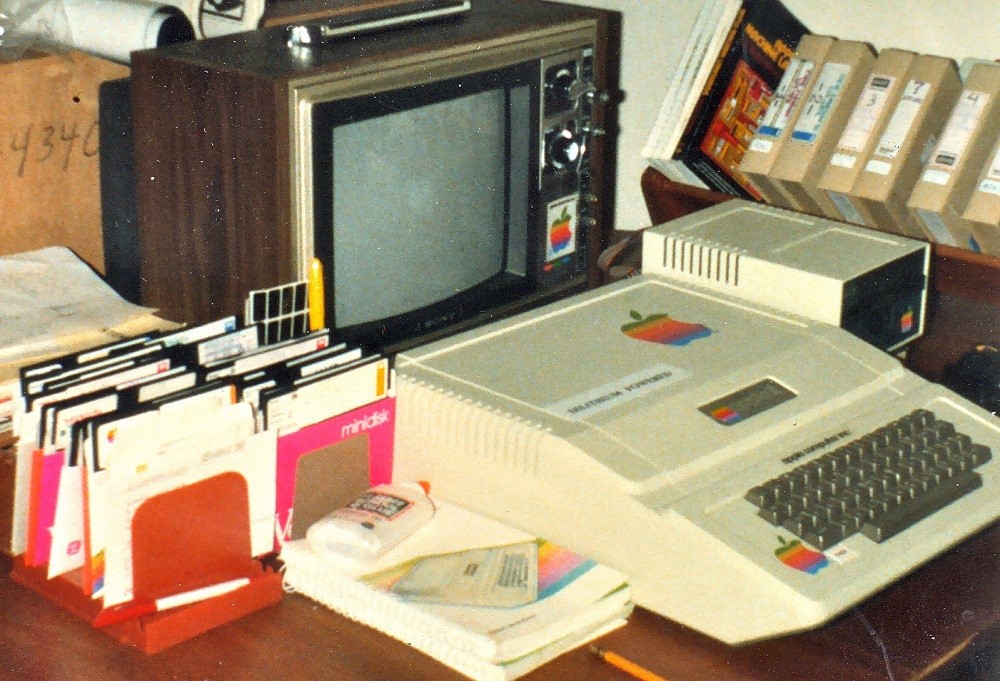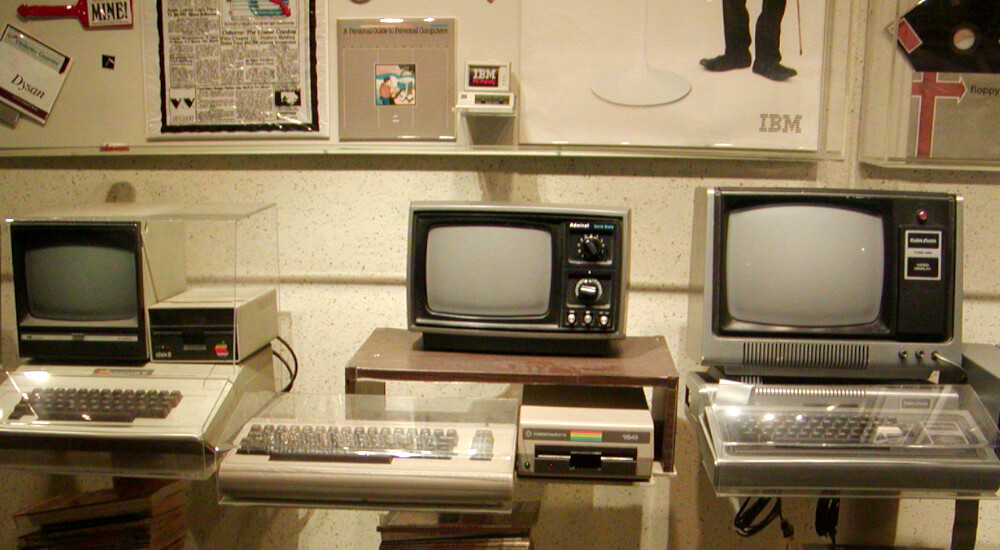"Save" the old software - three projects that do it
Back in 2014, Microsoft transferred the MS-DOS 1.25 and 2.0 code to the Computer History Museum , and in early October of this year, this code was uploaded to GitHub . But not only Microsoft is engaged in the preservation of historical software heritage. There are several global projects whose goal is to preserve old software. We will tell about them in today's material.

/ photo by Steve Jurvetson CC / Apple II
The Internet archive is better known for its collection of web pages , but the project also collects old software . The library with programs in the Internet Archive appeared in 2013. She is supervised by Jason Scott, adding to the archive manually. It transfers to the cloud data from physical media: CD-ROM, floppy disks, and even code from journals and catalogs.
')
In general, the "source" Jason donate the same enthusiasts and collectors. One day, he launched a campaign to search for all AOL trial disks . He wrote to the owner of the site cdrom.com and transferred to the Internet Archive a large collection of desired CDs.
According to Jason, he began to “save” software, because he understood how fragile the digital world was. Creating a perfect copy of the program is very easy, but if you do not do it in time, it will be lost forever.
Some programs of the Archive site visitors can “feel” right in the browser. For example, there are games from vintage portable consoles that are launched using the MAME emulator . The collection includes Donkey Kong , Mortal Combat and even Tamagotchi .
There are also programs for old computers. The archive has a selection dedicated to Apple II. She is not supervised by Jason himself, but by a hacker under the pseudonym 4am. It bypasses the protection of old school programs and makes them available to the global community. According to Jason Scott, 4am saves software, which otherwise would have been preserved only in the form of advertising in a magazine (or disappeared altogether).
4am saves not only games (like Aliens and Pac-Man ), but also programs for work, such as the font converter and image converter Graphics Converter , released in 1988.
In a separate collection saved the game for MS-DOS - there are more than two thousand.
Another interesting collection in the archive is a library for Macintosh computers from 1984-1989, when users first encountered the graphical interface. Here you can work with MacOS System 6 and draw in MacPaint .
If the Internet Archive is trying to preserve cultural heritage, then the Olive project has a slightly different goal. Olive founders believe that old programs are important to keep for future scientists.
The scientific method is based on reproducible results. The future generation of researchers should be able to reproduce the original conditions of the experiments. Therefore, it is important to save the programs that researchers use for calculations or simulations. For the creators of Olive, saving vintage software is a way to ensure continuity in science.
Olive is developed by scientists from Carnegie Mellon University. Now the project is inaccessible to ordinary users, only people who have contributed to the creation of the system can work with it. This is due to licensing restrictions for programs in the collection. In the future, project participants plan to open their library to the general public.
However, now you can download the client part of Olive. It's called VMNetX, it can run virtual machines from any server, runs on Linux, and uses KVM. The code can be found on github .
So far, 17 programs are available in the Olive service. They were chosen by the scientists themselves depending on their interests and preferences. The project library has both games and more “serious” services. Thus, for scientific purposes, researchers have saved the application for calculating taxes TurboTax 1997 and the environment for modeling tissues of the body Chaste 3.1 from 2013.

/ photo Q Family CC
The founders of the project are planning to create their own environment for launching programs, which will be provided for use by private and public companies and researchers. One example of a possible use of the Olive environment is working with NASA. The agency will be able to reproduce the systems of launched spacecraft in Olive and correct errors in their work.
The Software Preservation Network is developing two software preservation projects at once.
The first is being developed at Yale University. The goal of the researchers is to create an infrastructure using the Emulation-as-a-Service model, which users can save and run on virtual machines any programs. The first 3 thousand applications there will "make" the developers themselves. Work on the project began in February 2018, and its completion is scheduled for June 2020. The service will be available to students and university staff.
The second project is called Fostering a Community of Practice (FCoP). For him, the Software Preservation Network selected six applications from libraries and museums with initiatives to preserve outdated software. By May 2020, participants will submit their digital archives with old programs.
One of the projects proposed by the team of the Solomon Guggenheim Museum. They will create a system for preserving digital works of art. Another project belongs to the Library of Georgia University of Technology. Its employees will develop a service in which users will be able to access programs from the library collection and training materials on this software.
PS Some fresh materials from the First Corporate IaaS blog:
PPS And we also have our own Telegram channel :

/ photo by Steve Jurvetson CC / Apple II
Internet Archive
The Internet archive is better known for its collection of web pages , but the project also collects old software . The library with programs in the Internet Archive appeared in 2013. She is supervised by Jason Scott, adding to the archive manually. It transfers to the cloud data from physical media: CD-ROM, floppy disks, and even code from journals and catalogs.
')
In general, the "source" Jason donate the same enthusiasts and collectors. One day, he launched a campaign to search for all AOL trial disks . He wrote to the owner of the site cdrom.com and transferred to the Internet Archive a large collection of desired CDs.
According to Jason, he began to “save” software, because he understood how fragile the digital world was. Creating a perfect copy of the program is very easy, but if you do not do it in time, it will be lost forever.
Some programs of the Archive site visitors can “feel” right in the browser. For example, there are games from vintage portable consoles that are launched using the MAME emulator . The collection includes Donkey Kong , Mortal Combat and even Tamagotchi .
There are also programs for old computers. The archive has a selection dedicated to Apple II. She is not supervised by Jason himself, but by a hacker under the pseudonym 4am. It bypasses the protection of old school programs and makes them available to the global community. According to Jason Scott, 4am saves software, which otherwise would have been preserved only in the form of advertising in a magazine (or disappeared altogether).
4am saves not only games (like Aliens and Pac-Man ), but also programs for work, such as the font converter and image converter Graphics Converter , released in 1988.
In a separate collection saved the game for MS-DOS - there are more than two thousand.
Another interesting collection in the archive is a library for Macintosh computers from 1984-1989, when users first encountered the graphical interface. Here you can work with MacOS System 6 and draw in MacPaint .
Olive
If the Internet Archive is trying to preserve cultural heritage, then the Olive project has a slightly different goal. Olive founders believe that old programs are important to keep for future scientists.
The scientific method is based on reproducible results. The future generation of researchers should be able to reproduce the original conditions of the experiments. Therefore, it is important to save the programs that researchers use for calculations or simulations. For the creators of Olive, saving vintage software is a way to ensure continuity in science.
Olive is developed by scientists from Carnegie Mellon University. Now the project is inaccessible to ordinary users, only people who have contributed to the creation of the system can work with it. This is due to licensing restrictions for programs in the collection. In the future, project participants plan to open their library to the general public.
However, now you can download the client part of Olive. It's called VMNetX, it can run virtual machines from any server, runs on Linux, and uses KVM. The code can be found on github .
So far, 17 programs are available in the Olive service. They were chosen by the scientists themselves depending on their interests and preferences. The project library has both games and more “serious” services. Thus, for scientific purposes, researchers have saved the application for calculating taxes TurboTax 1997 and the environment for modeling tissues of the body Chaste 3.1 from 2013.

/ photo Q Family CC
The founders of the project are planning to create their own environment for launching programs, which will be provided for use by private and public companies and researchers. One example of a possible use of the Olive environment is working with NASA. The agency will be able to reproduce the systems of launched spacecraft in Olive and correct errors in their work.
Software Preservation Network Projects
The Software Preservation Network is developing two software preservation projects at once.
The first is being developed at Yale University. The goal of the researchers is to create an infrastructure using the Emulation-as-a-Service model, which users can save and run on virtual machines any programs. The first 3 thousand applications there will "make" the developers themselves. Work on the project began in February 2018, and its completion is scheduled for June 2020. The service will be available to students and university staff.
The second project is called Fostering a Community of Practice (FCoP). For him, the Software Preservation Network selected six applications from libraries and museums with initiatives to preserve outdated software. By May 2020, participants will submit their digital archives with old programs.
One of the projects proposed by the team of the Solomon Guggenheim Museum. They will create a system for preserving digital works of art. Another project belongs to the Library of Georgia University of Technology. Its employees will develop a service in which users will be able to access programs from the library collection and training materials on this software.
PS Some fresh materials from the First Corporate IaaS blog:
- GDPR effect: how the new regulation has affected the IT ecosystem
- "How are VMware?": A review of new solutions
PPS And we also have our own Telegram channel :
Source: https://habr.com/ru/post/427971/
All Articles